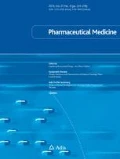Summary
In recent years biological weapons have become key political issues in the US and to a lesser extent within NATO. Increasing amounts of time and money are being devoted to this particularly amoral weapon of mass destruction. With the success of the nuclear and chemical weapons conventions there has been a realization that the present Biological and Toxins Weapons Convention (BTWC) is inadequate for the twenty-first century. In particular, it has obvious deficiencies with respect to verification and enforcement procedures. Since the commissioning of the UN Ad Hoc Group on biological weapons, the biotechnology and pharmaceutical industry have been identified as key components for counter-proliferation and control measures. This article examines the implications of biological weapons verification and export controls on the pharmaceutical industry. However, we begin with a brief historical and political introduction to this complex subject.




Similar content being viewed by others
References
Porter R. The eighteenth century. In: Conrad L, Neve M, Nutton V, Porter R, Wear A eds. The western medical tradition. Cambridge: Cambridge University Press, 1995.
Biggs R. Medicine in ancient Mesopotamia. Hist Sci 1969; 8:96–97.
Neufeld E. Insects as warfare agents in the ancient Near East. Orientalia 1980; 49:30–57.
Wheelis M. Biological warfare before 1914: the prescientific era. In: Geissler E, van Courtland Moon JE eds. Biological and toxin weapons research, development and use from the middle ages to 1945. Oxford: Oxford University Press, 1998.
Wheelis M. Biological sabotage in the First World War. In: Geissler E, van Courtland Moon JE eds. Biological and toxin weapons research, development and use from the middle ages to 1945. Oxford: Oxford University Press, 1998.
Mobley JA. Biological warfare in the twentieth century: lessons from the past, challenges for the future. Mil Med 1995; 160:547–553.
Hay A. Simulants, stimulants and diseases: the evolution of the United States biological warfare programme, 1945–60. Med Confl Surviv 1999; 15:198–214.
Leitenberg M. The biological weapons program of the former Soviet Union. Biologicals 1993; 21:187–191.
Hay A. A magic sword or a big itch: an historical look at the United States biological weapons programme. Med Confl Surviv 1999; 15:215–234.
Huxsoll DL. Narrowing the zone of uncertainty between research and development in biological warfare defence. Ann NY Acad Sci 1992; 666:177–190.
Barton R. The application of the UNSCOM experience to international biological arms control. United Nations Special Commission. Crit Rev Microbiol 1998; 24:219–233.
Seth Carus W. Biological Weapons. Report to the Senate Select Committee on Intelligence, Senate Judiciary subcommittee on technology, terrorism and governmental information, 1998.
British Medical Association. Biotechnology, weapons and humanity. Netherlands: Harwood Academic, 1999.
Henderson DA. Weapons of the future. Lancet 1999; 354:64–64.
Wise R. Bioterrorism: thinking the unthinkable. Lancet 1998; 351:1378–1378.
Kaufmann AF, Meltzer MI, Schmid GP. The economic impact of a bioterrorist attack: are prevention and post-attack intervention programs justifiable? Emerg Infect Dis 1997; 3:83–94.
Macintyre AG, Christopher GW, Eitzen EMJ, Gum R, Weir S, DeAtley C et al. Weapons of mass destruction events with contaminated casualties. JAMA 2000; 283:242–249.
Waelsch SG. Domestic preparedness for events involving weapons of mass destruction. JAMA 2000; 283:252–254.
Hinton HL. Combating terrorism. Observations for Federal spending to combat terrorism. Government Reform, National Security, Veterans Affairs and International Relations. GAO/T-NSIAD/GGD-99-107, 1999.
Seth Carus W. Testimony of W. Seth Carus on Biological Weapons. Report to the Intelligence and Judiciary, Technology, Terrorism and Government Information Committee,1998.
Kupperman RH, Trent DM. Terrorism: threat, reality, response. California: Hoover Institution Press, 1979.
Wiener SL. Terrorist use of biological weapons. Terrorism 1991; 14:129–133.
Henderson DA, Inglesby TV, Bartlett JG, Ascher MS, Eitzen E, Jahrling PB et al. Smallpox as a biological weapon: medical and public health management. Working Group on Civilian Biodefense. JAMA 1999; 281:2127–2137.
Inglesby TV, Henderson DA, Bartlett JG, Ascher MS, Eitzen E, Friedlander AM et al. Anthrax as a biological weapon. Medical and public health management. JAMA 1999; 281:1735–1745.
Cohen HW, Gould RM, Sidel VW. Bioterrorism initiatives: public health in reverse. Am J Public Health 1999; November:23–29.
Henderson DA. The looming threat of bioterrorism. Science 1999; 283:1279–1282.
US Department of Defence (OotSoD). Proliferation: threat and responses, 1997.
Russian Foreign Intelligence (FIS). A new challenge after the cold war: Proliferation of weapons of mass destruction. JPRS-TND-93-007. Joint Publication Research Service, 1993.
Barkho L. Iraq shows foreign reporters main biological sites. London: Reuter News Service, 1995.
Zilinskas RA. Iraq’s biological weapons. The past as future? JAMA 1997; 278:418–424.
Hamre JJ. Hamre: counter-proliferation efforts must include defence against cyberattacks and weapons of mass destruction. Defence Viewpoint 1998; 13:12–18
Butler D. Talks start on policing bio-weapons ban... as ‘designer weapons’ threat is disputed. Nature 1997; 388:317–317.
FAS. Confidentiality can be protected during sampling and analysis in a BWC compliance regime. Federation of American Scientists,1997.
Melling J. Issues relating to on-site sampling and analysis. Federation of American Scientists, 1997.
MacEachin DJ. Routine and challenge: two pillars of verification. Q J Harvard Sussex Program on CBW Armament and Arms Limitation: University Press; 1998.
Pearson GS, Dando M. The necessity for non-challenge visits (NCVs). Federation of American Scientists, 2000.
Dando M, Pearson GS. The Fourth Review Conference of the Biological and Toxin Weapons Convention: Issues, out-comes, and unfinished business. Politics Life Sci 1997; 16:105–126.
Zilinskas RA. Verifying compliance to the Biological and Toxin Weapons Convention. Crit Rev Microbiol. 1998; 24:195–218.
US Department of Commerce. Bureau of Export Administration. Foreign availability review. AG BW Controls: Proposed equipment items. BXA/OFA 92-12R. Washington DC: US Dept of Commerce, 1992.
Franz DR. Inventory control of dual-use equipment. Politics Life Sci 1995; 14:244–247.
Roberts B. Export controls and biological weapons: new roles, new challenges. Crit Rev Microbiol 1998; 24:235–254.
FAS. Means for protecting US industry within an effective compliance regime for the biological weapons convention. Federation of American Scientists, 1999.
Author information
Authors and Affiliations
Rights and permissions
About this article
Cite this article
Gorka, S., Sullivan, R. Biological weapons and the pharmaceutical industry. International Journal of Pharmaceutical Medicine 14, 213–218 (2000). https://doi.org/10.1097/00124363-200008000-00009
Received:
Accepted:
Published:
Issue Date:
DOI: https://doi.org/10.1097/00124363-200008000-00009




